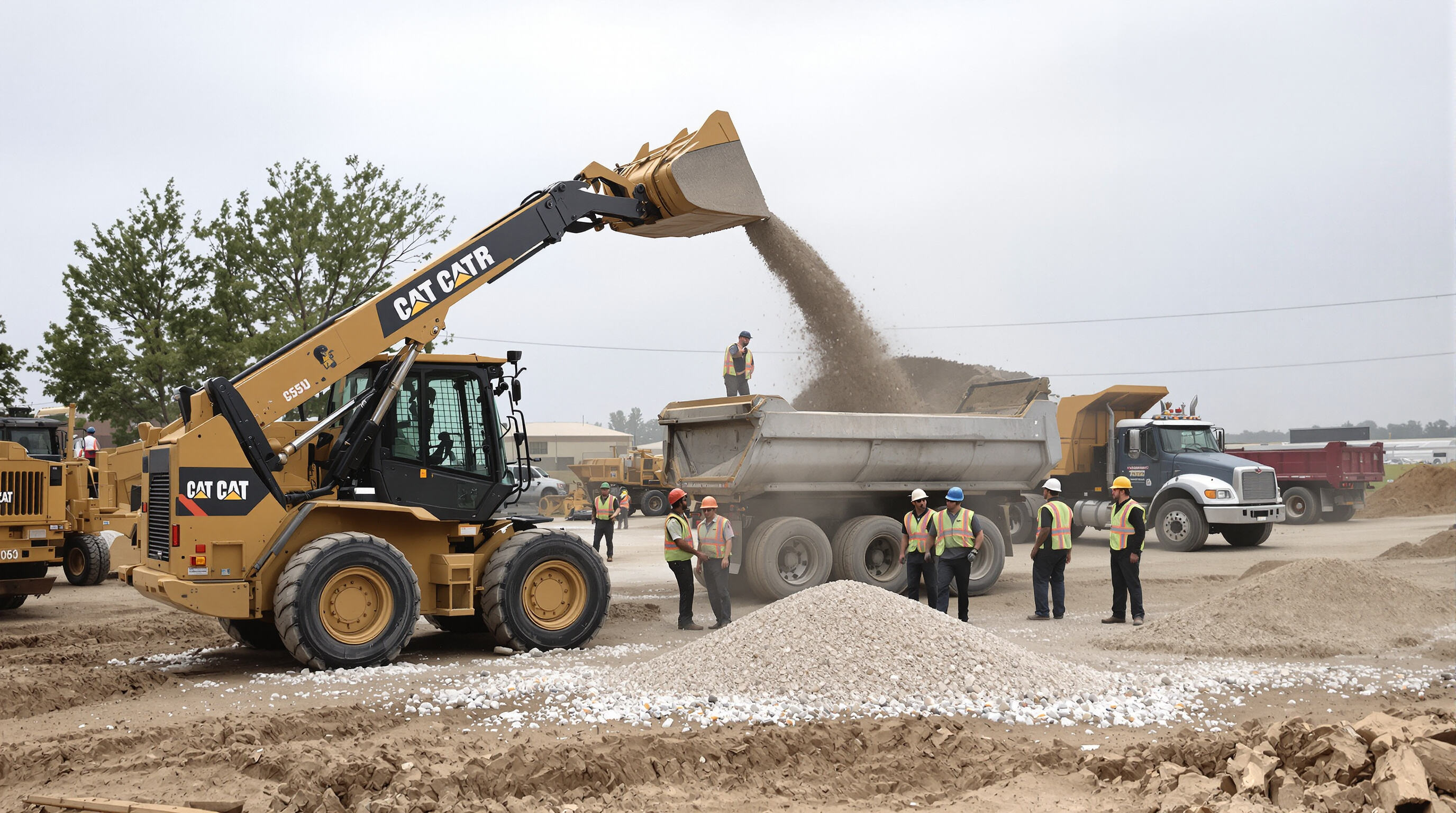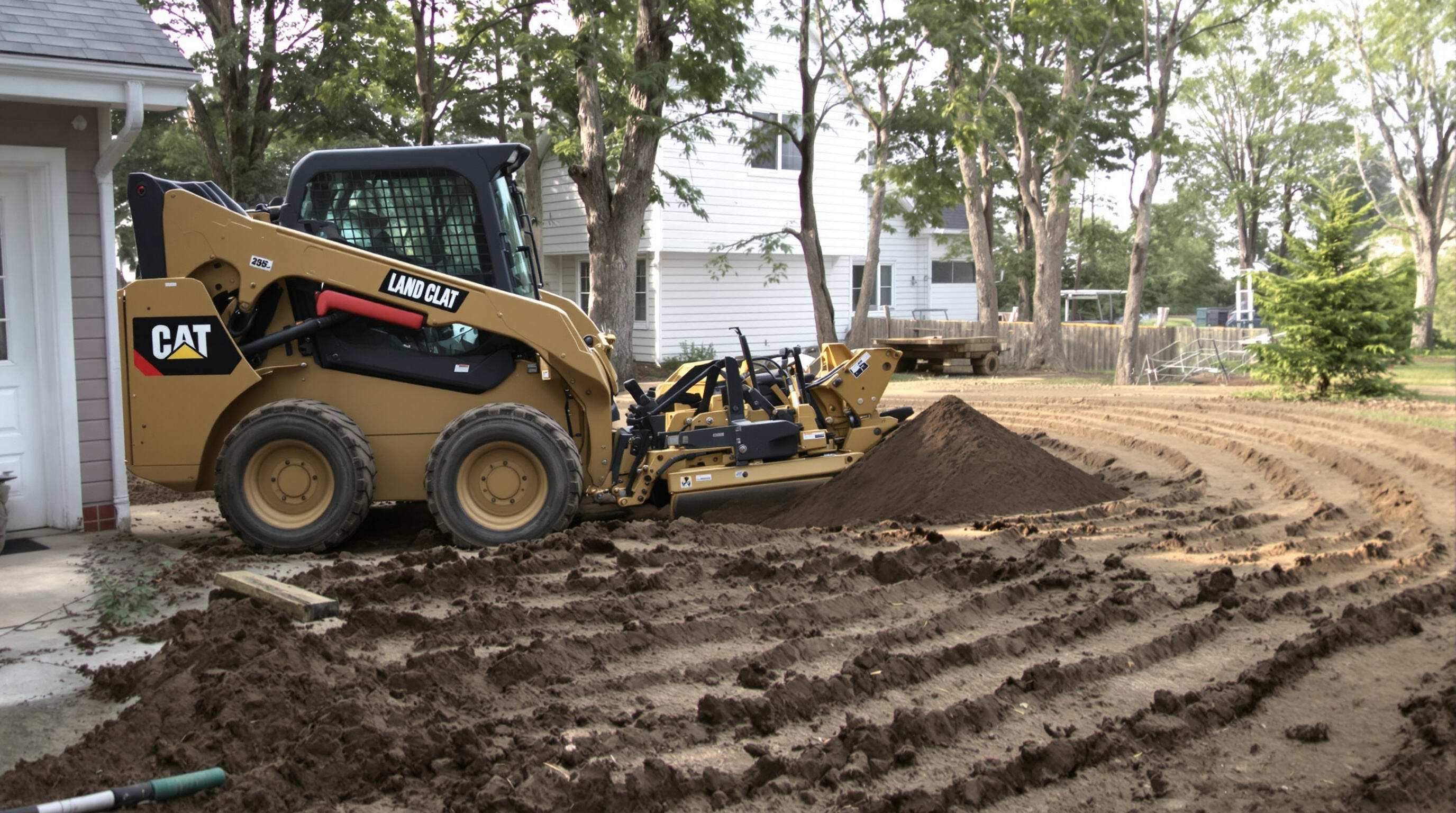Skid Loader of Material Handling: Efficient Loading, Transporting, and Site Mobility

Using the boom and bucket for lifting and dumping materials
Skid loaders are really good at handling materials because they're small but pack a punch with their hydraulic boom systems. Most models can handle around 2,500 pounds in the bucket, which makes these machines great for cleaning up construction sites, moving gravel, or transporting farm goods. What sets them apart is that the bucket can rotate all the way around 180 degrees. This means operators can dump materials right where they need to go without much hassle. Less stuff spills out during unloading, and workers don't have to keep moving the loader back and forth as often. The whole process becomes smoother and faster on job sites.
Scooping and moving materials across construction and job sites
Skid steer loaders pack quite a punch thanks to their powerful hydraulic systems and ability to turn on a dime, which keeps them productive even on bumpy ground or in tight spaces. These machines shine particularly well in city construction sites where space is limited and in greenhouses where precision matters. According to recent research from last year's equipment usage report, workers actually cut down on time spent moving stuff around by almost a third when using these loaders instead of doing it all by hand. Think about hauling gravel for landscaping projects or shifting bags of mulch around a property – what used to take hours now gets done much faster with proper machinery.
Loading trucks and dumping materials with precision
Today's skid steer loaders come equipped with smart load sensing tech that automatically adjusts hydraulic pressure depending on what's in the bucket. This makes operations safer and more efficient overall. Operators can typically fill regular dump trucks within around 6 to 8 cycles thanks to this system, plus they get better visibility with those handy rear view cameras mounted on the machine. The main advantages? Weight measurements stay pretty accurate within about 2% when handling aggregates, and there's noticeably less fuel burned because the lifting and dumping cycles work so much better together. Many contractors have seen these improvements translate directly into cost savings and improved productivity on job sites.
Maximizing productivity in warehouses and agricultural settings
In warehouses, skid loaders handle pallets and bulk transport using attachments like forklift arms. In agriculture, they distribute feed at rates up to 8 tons/hour, clean livestock areas, and load manure spreaders with minimal ground disturbance. The table below highlights efficiency gains across sectors:
| Sector | Task | Productivity Increase |
|---|---|---|
| Construction | Debris removal | 40% |
| Agriculture | Feed distribution | 55% |
| Warehousing | Pallet relocation | 30% |
Case study: Material handling efficiency on a commercial build site
During a highway expansion project, skid loaders moved 850 tons of excavation material daily using buckets and grapples, achieving 94% truck fill accuracy. Site managers reported a 23% reduction in equipment costs compared to using wheel loaders and excavators.
Excavation and Digging: Compact Power for Tight-Space Projects
Using a Skid Steer for Digging and Grading in Tight Spaces
Skid loaders are ideal for confined areas where larger excavators can’t operate. Their zero-tail-swing design and 360° visibility allow precise digging of footings, grading, and backfilling near walls or obstacles. The articulated boom provides fine control for shaping slopes or creating drainage ditches in residential or urban settings.
Comparing Skid Loader Digging Depth to Mini Excavators
While mini excavators typically reach 10–14 feet–2–3 feet deeper than skid loaders–skid steers outperform them in tight spaces, requiring 30% less working area. Their quick-attach systems also allow rapid switching between digging and grading attachments, eliminating the need for multiple machines.
Best Practices for Trenching and Foundation Work
- Use laser-guided grading attachments for ±1° slope accuracy.
- Conduct ground scans before trenching to avoid underground utilities.
- Equip tires with reinforced sidewalls when working near sharp debris.
- Limit hydraulic breaker use to 15-minute cycles to prevent overheating.
Data Insight: 68% of Contractors Use Skid Steers for Small-Scale Excavation
A 2024 industry survey found that 68% of contractors prefer skid loaders for excavation tasks under 8 feet deep, citing 22% faster completion in tight spaces. This reflects growing recognition of their dual capabilities in excavation and material handling.
Grading, Landscaping, and Site Preparation with Skid Loader Attachments

Skid steer applications in leveling soil and preparing building pads
Skid steer loaders get plenty of work around construction sites and landscaping projects where flat ground matters. These machines pack a punch despite their small size, making it possible to reach those awkward spots between buildings or under trees. With attachments like grading buckets and land planes attached, operators can move dirt around with surprising accuracy. Most contractors consider these little workhorses essential when setting up foundations because they make sure water drains properly away from structures. Nobody wants cracks forming in walls or floors later down the road simply because someone didn't grade the site right initially.
Using grapple buckets and box blades for precise grading
Grapple buckets allow operators to grip and reposition debris-laden soil, enhancing grading accuracy. Box blades with adjustable scarifiers break up compacted ground, while rear blades deliver a finished surface. Together, these attachments achieve grades within 2% of design specifications–essential for ADA-compliant walkways and foundation work.
Common applications of skid steers in residential and commercial landscaping
From backyard terraces to parking lot foundations, skid loaders handle diverse grading tasks. Residential landscapers use them for pool prep, retaining wall bases, and garden bed shaping. Commercial crews deploy them for sports field grading and stormwater swales. Their zero-turn radius is invaluable when working around existing structures.
Using augers, tillers, and mulchers for planting and soil prep
Skid steer-mounted augers drill over 100 post holes per day with minimal disruption. Rotary tillers prepare seedbeds 50% faster than manual methods, and forestry mulchers process brush into ground cover at rates exceeding 2 acres per day. These attachments enable single-machine completion of full landscape installations.
Efficiency gains in tree removal and stump grinding
By combining grapples for debris handling and high-torque stump grinders, operators achieve 75% faster tree removal than manual crews. The skid loader’s stability supports hydraulic attachments delivering up to 1,800 ft-lbs of torque–enough to grind 36" stumps without repositioning.
Snow Removal, Farming, and Demolition: Versatile Skid Loader Applications
Equipping skid loaders with snow blowers and plows for winter maintenance
Skid loaders become essential winter tools when fitted with snow blowers or plow attachments. Their compact size allows precise operation in narrow spaces like parking garages and farm lanes, while consistent hydraulic power handles heavy snow and ice effectively.
Municipal and commercial snow removal case study
A municipal case study showed skid loaders reduced snow-clearing time by 35% in urban environments compared to traditional plows. Operators emphasized the advantage of quickly switching between bucket and blower attachments to respond to changing snow conditions.
Handling feed, cleaning barns, and managing manure in agricultural settings
Farmers use pallet forks to stack hay and buckets to clean stalls. With lifting capacities between 1,500 and 3,000 lbs, one operator can clear a 50-stall barn in under two hours, significantly improving manure management efficiency.
Case study: Skid loaders in Chinese agro-operations
In northern China’s dairy farms, skid loaders with grapples improved feed distribution by 28% during 2023 winter trials. Their ability to navigate narrow barn aisles outperformed larger tractors, enhancing daily operational flow.
Demolition and debris removal with hydraulic breakers and grapples
Hydraulic breakers on skid loaders deliver up to 1,200 ft-lbs of impact force for concrete demolition, while grapples manage 95% of metal debris sorting. This setup is ideal for dismantling single-story structures in confined spaces.
Strategy: Minimizing downtime with quick-attach systems in heavy-duty jobs
A 2024 equipment efficiency study found that standardized quick-attach systems enabled operators to complete 40% more tasks per shift. The pin-and-lock mechanism allows attachment changes in under 60 seconds, which is critical when transitioning between snow removal, excavation, and material handling.
Frequently Asked Questions (FAQ)
What is a skid loader used for?
Skid loaders are versatile machines used for material handling, excavation, grading, landscaping, snow removal, and demolition, among other applications.
How much weight can a skid loader handle?
Most skid loaders can handle around 2,500 pounds in the bucket.
Are skid loaders efficient for material handling?
Yes, skid loaders are efficient in material handling due to their hydraulic systems and the ability to rotate the bucket 180 degrees, ensuring accurate placement and minimizing spillage.
How do skid loaders compare to mini excavators?
While mini excavators can reach greater depths, skid loaders outperform in tight spaces and require less working area. They are also more versatile when equipped with quick-attach systems.
Table of Contents
-
Skid Loader of Material Handling: Efficient Loading, Transporting, and Site Mobility
- Using the boom and bucket for lifting and dumping materials
- Scooping and moving materials across construction and job sites
- Loading trucks and dumping materials with precision
- Maximizing productivity in warehouses and agricultural settings
- Case study: Material handling efficiency on a commercial build site
- Excavation and Digging: Compact Power for Tight-Space Projects
-
Grading, Landscaping, and Site Preparation with Skid Loader Attachments
- Skid steer applications in leveling soil and preparing building pads
- Using grapple buckets and box blades for precise grading
- Common applications of skid steers in residential and commercial landscaping
- Using augers, tillers, and mulchers for planting and soil prep
- Efficiency gains in tree removal and stump grinding
-
Snow Removal, Farming, and Demolition: Versatile Skid Loader Applications
- Equipping skid loaders with snow blowers and plows for winter maintenance
- Municipal and commercial snow removal case study
- Handling feed, cleaning barns, and managing manure in agricultural settings
- Case study: Skid loaders in Chinese agro-operations
- Demolition and debris removal with hydraulic breakers and grapples
- Strategy: Minimizing downtime with quick-attach systems in heavy-duty jobs
- Frequently Asked Questions (FAQ)


